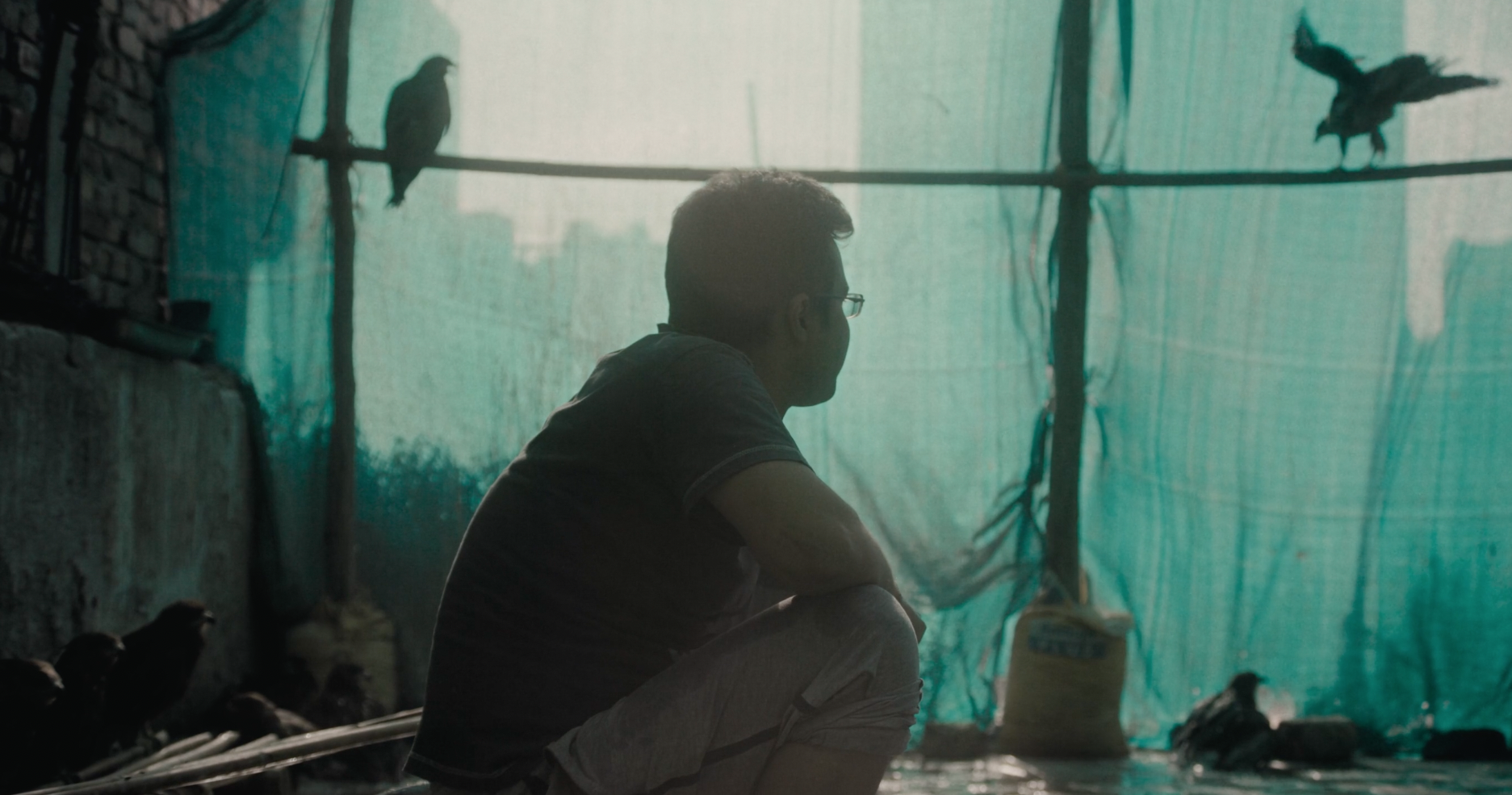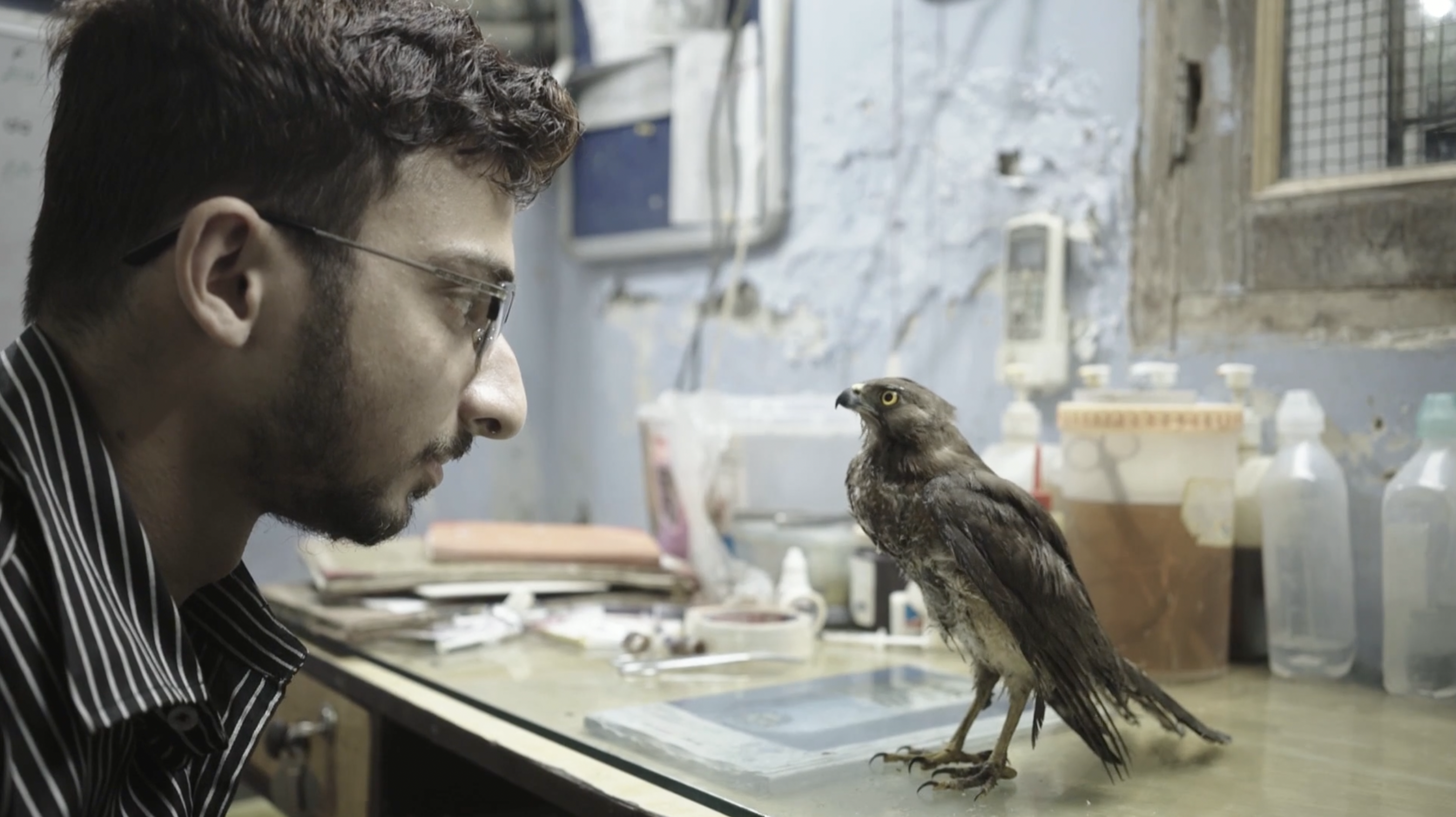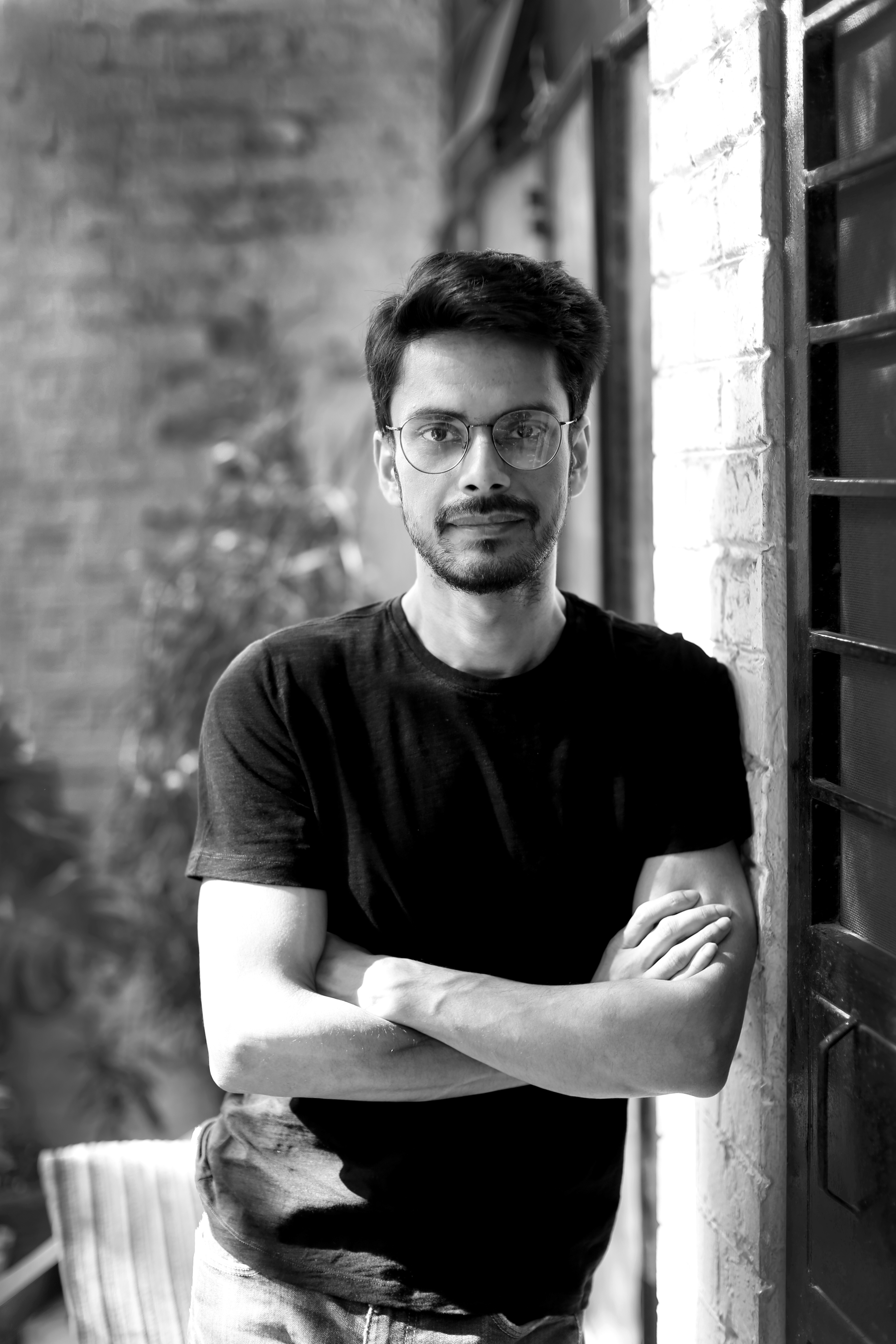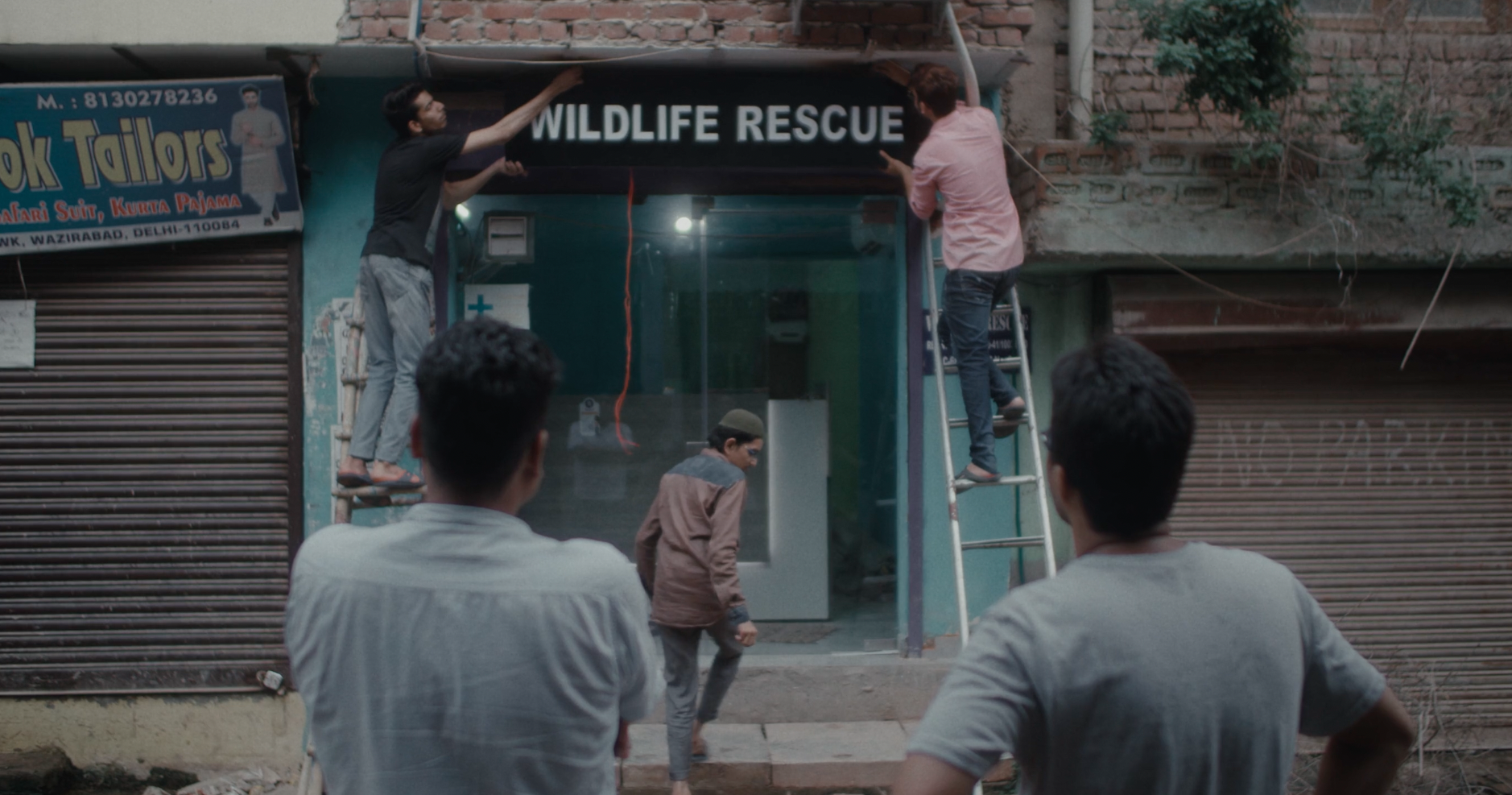Shaunak Sen's 'All That Breathes': A Great Gray Triangulation of Air, Birds and Men
 I remember watching Shaunak Sen’s first film, Cities of Sleep, in a college auditorium in New York, where Sen and his friends walked around with DVDs in hand, distributing the film about Delhi at night, to whoever would screen it.
I remember watching Shaunak Sen’s first film, Cities of Sleep, in a college auditorium in New York, where Sen and his friends walked around with DVDs in hand, distributing the film about Delhi at night, to whoever would screen it.
Delhi—or Dilli, as it is called in several South Asian languages—makes cynics out of most of us who have lived there. The trite thing to ask after, often, is the “dil” (heart) in Dilli. As I watched Sen’s new film, All That Breathes, premiere at Sundance, I reacquainted myself with the city’s heart as it took flight on the wings of the black kites that dot Delhi’s skies; as it lay nestled in the basement where Nadeem, Saud, and Salik—the film’s protagonists—nurse wounded kites back to health; and as it soared high in defiance of imminent, ever-present mortality.
Following its winning the Grand Jury Prize in World Cinema Documentary Competition at Sundance, All That Breathes won the L'Œil d'or, le prix du documentaire at Cannes. Ahead of its theatrical run in Los Angeles and New York, and eventual HBO rollout, Documentary caught up with Sen over a long, early-morning Zoom call. This interview has been edited for length and clarity.
DOCUMENTARY: Let’s go back to the beginning. How did you meet Nadeem, Saud, and Salik, and how did you decide to tell their story?
SHAUNAK SEN: I was in a fellowship in the UK, at Cambridge, and was around people who were working on human-animal relationships, physiologically. Somebody was working on polar bears, somebody was working on vegetation in Fukushima, and generally speaking, there was a lot of philosophical rigor around the human-animal index. At the project’s most incipient stage, I got interested in and started looking for people who personified or embodied deep or profound relationships with the skies. Back then I had a vague sense, or a texture, of what the film ought to be. If you lived in Delhi for a while, everybody knows that there’s this kind of gray sensorium. The air that you’re breathing, you’re constantly feeling like you’re suspended in a kind of ethos that is foundationally antithetical to your sense of sustenance and nourishment.
At the film’s earliest stages, what I was interested in was a kind of grayness. Like this haze that sort of laminates our lives and the entirety of the city from September all the way to January. So that’s how it essentially began. It largely was a triangulation of meditation on air, on the color gray, and something to do with birds.
 D: Why birds?
D: Why birds?
SS: I would keep looking at these low, gliding dots in the sky, which are the “cheels,” the black kites. When you’re driving and you’re stuck in traffic, and you look up, you constantly see these circling birds. At some point, you inevitably end up imagining what would happen if you see a kite fall.
D: Because how they sharply dive and plunge…
SS: Yes. I got fairly gripped by the idea of what happens when a bird falls from this gray sky, and that’s how I came across the work of Nadeem and Saud.
D: What was that first time visiting their home-cum-dispensary-cum-basement office like?
SS: The minute you visit their house for the first time, you see that tiny, dingy basement full of industrial decay on one side and very vulnerable birds on the other. It’s so inherently cinematic.
The basement, the house, and the sheer absurdity of their living conditions draw you in. It was clear that the two brothers, their work and the family could become a kind of a metaphor where they encapsulated a large number of currents I wanted to be in conversation with.
D: There was something I noticed as the brothers struggled to find funding for their work. It kind of mirrors the struggles of the filmmaking process. Would you say that is true?
SS: I’ve not been asked that before, but I see what you’re nudging towards. Having said that, I don’t want to over-determine the consonances too much. There is precarity and a large deal of uncertainty that one has to soldier on against, amidst what feels like impossible odds. It’s not just a material battle but also a kind of emotional and spiritual battle on both these registers—both what they do and in indie filmmaking.
While there are some overlaps, our struggle is nowhere close to being that kind of an existential battle for survival. For them, even though they do run a business for a kind of a baseline livelihood, what it would mean for the workaround birds to stop, is foundationally incomparable to what it would mean for a film to not fructify, for me.
It would of course be really heart-wrenching for me if the film were to shut down in the middle.
D: Sorry to take a detour here, but did the film ever shut down? How different is making your second film from making your first one?
SS: For Cities of Sleep, the precarity and vulnerability of filmmaking was constantly bearing in, into my personal life. Because you’re not used to that; you don’t yet have a kind of appetite for the patience and the long haul that it requires.
For All That Breathes, I was far more strategic and tactful. I’d gone through the whole rut of not knowing what’s gonna happen. “How will you ever finish the film? The money’s too little. The work’s too much.” You have to move worlds to mount a film; there’s no other way of saying that. Given the fact that all resources are obviously incredibly sparse, there are barely any precedents for the kind of film that you want to make, especially in our corner of the world.
So, all in all, you feel like you’re constantly trying to do something impossible without any support of any kind. Even to your well-wishers, you can’t really say what the film that you’re trying to make looks like. You don’t have too many straws to clutch at. However, your experience helps and that became a kind of life raft for me.
 D: So what did your experience teach you?
D: So what did your experience teach you?
SS: I was able to be tactical. I understood that in the first year, you are not really making a film. You’re writing a bunch of proposals, you’re making a ton of demo reels, and you’re doing a lot of pitches. You’re not really filming. You’re a professional grant writer for that first year. We kept pitching constantly.
We were able to pace ourselves and were better prepared to scale our jumps, especially because the ambition of the film was to be poetic and cinematic, which requires its own kind of resource-intensive infrastructure departments.
D: Now going back to that question of whether these struggles are similar…
SS: I don’t want to in any way overstate that our struggle is like theirs, because it really very much isn’t. They’re both struggles—I suppose you can say that there are similar veins that are imbricated in both. Nadeem and Saud both often say “Hum pagal hain” (We are crazy to do this) and then their joke, over time, became “Aap bhi pagal ho.” (You are crazy to do this too). Obviously, both their work and mine require some kind of a mulish obstinacy at best, and delirium at worst. It requires for you to motor on and soldier on to make a film when you don’t really see the end point of the finishing line.
But if the bird work ends for them, I don’t know what it would do to their sense of life being a meaningful, substantial enterprise. The way they draw meaning from life emotionally, morally, ethically and philosophically is predicated entirely on the work that they do.
D: Is it a similar meaning-making process, with you and cinema?
SS: Cinema is very deeply intertwined with the fabric of my life, but it definitely isn’t entirely premised on it in the way that theirs is, on the bird work. Also, with the levels of vulnerability, it would be fairly blinkered and tone-deaf to say that there are obvious parallels in the way that one can be transposed onto the other. The risk of sounding self-congratulatory here is fairly high, so I am making this distinction. But we often keep joking about the kinship of impractical silliness and madness that ties us together.
D: It’s been a while since I watched Cities of Sleep, but I remember there was a feeling of being horizontal in the film. And this one is a very vertical film, especially the way the camera moves, and you see a different slice of the city from a different angle. Was that something you were consciously doing?
SS: You’re right. There, the main lens through which the urban was disassembled was the horizontal axis. Horizontality was not just an optical field in terms of thinking about what happens when bodies become lateral and how our relationships with the city, and each other, change the minute the nighttime city opens up.
In this film, it’s a vertical axis. Because you’re thinking about the air and the relationship between the bird and the human. It all becomes more interesting because of these multiple registers.
D: Were there specific inspirations here?
SS: Of course. I was reading a lot of really excellent literature around avian culture. The Peregrine by J.A. Baker, which is some phenomenal prose on just observing the peregrine falcon. Then there was Helen Macdonald’s remarkable H Is for Hawk. In all of this, I realized that this inhabitation of the sky, this occupying of the eddies and currents of the sky, is a world that is totally different. There’s a line in the film that talks about seeing a kind of alien-reptilian intelligence when you look a kite in its eye. This is because we are creatures that are constantly stapled to the ground, our lives are mostly two-dimensional because we’re constantly plastered to our relationship with gravity. That orders our experience of how we make sense of the world.
The bird is a figure of phenomenal literature, art, and poetry because it makes us hope. So verticality becomes a really delicious kind of lens through which we can look at human-animal relationships. But I was also, in particular, very interested in this love affair between man and bird.
D: What, in your head, would witnessing that affair look like?
SS: The idea was to enchant the skies. I wanted people to exit the theaters and look up. I spoke of it like a kind of ravenous, mad, hypnotic love for the bird and a kind of obsession. The kite appears in how the men speak about their childhood when they fed meat to the birds. It comes across as a truly, otherworldly, wondrous, mesmeric kind of creature. The idea was to try to capture that because that kind of obsessive hypnotism with the animal completely undercuts how the West thinks of animal care or animal love. It’s a different cosmology entirely. All of that constantly works on this vertiginous strata. That’s why the vertical was interesting.
D: When it comes to duty of care towards participants in your documentary, things are less formalized and less contractualized within India. I wanted to know how you approach relationships with the people in your film.
SS: It’s not a very complicated terrain because inherently there is something close to violent or extractive about a documentary enterprise. You go into somebody’s head, and you say that you will stay long and take, take, take. However, there is also, despite that, a quiet dignity, beauty, and poetics to the enterprise, and one tries to constantly lean in on the latter.
The question of talking to subjects and generating a conversation about active consent in terms of what is okay to shoot, what is not okay, what is the grammar of that shooting, is a constantly ongoing thing. It begins right when you start talking about the project, to when you are shooting, through the edit and so on.
There were many things we discovered and learned through the previous film wherein these questions were especially thorny because we were working with people who were far more disenfranchised. The gulf in privilege was wide, so one had to constantly be mindful of the compunctions of witnessing. In this case, both of the brothers are very media-savvy. Nadeem edits videos and is able to shoot, and so on. So, it began with me sitting them down and saying that this is a long project, it’s a long friendship. In my opinion, it’s always good to formalize things, to have some kind of a signed release, both ways. You don’t know who will say what, whose memory will fail.
Apart from that, there’s a really delicate, sweet spot or thin line between where you want to fully respect all your subjects’ choices about what should be in the film or not, which also is a constantly changing thing. What Salik, Saud and Nadeem were ready to talk to me about, or open up about, on Day One was not the same as Day 20, was not the same as Day 90, was not the same as Day 215 because it’s how life is, how human friendships work. It constantly waxes and wanes and changes.
What to keep and what not to keep is an active, constant conversation, and very often it’s an animated conversation. While I want to listen to everything they’re saying, at the same time I want to hold on to my autonomy as an artist and have my editorial choices. This wasn’t an NGO film and in no way do you want to make it a hagiography. You have to hold on to the sovereignty of your witnessing voice. Then there are questions of precarity and safety for the characters, which is also an ongoing thing. We had to constantly take stock of the changing coordinates of the public political sphere.
 D: Speaking of that, how do you as a filmmaker, and your film, remain safe in a delicate political environment?
D: Speaking of that, how do you as a filmmaker, and your film, remain safe in a delicate political environment?
SS: We had to carefully choose the things that communicate what we want people to sense. Obliquely. But at the same time, we have to be careful enough for it to not be egregiously foolhardy.
D: You made this film in India with funding that is largely international, and then the film is having this global journey. I wanted to talk about the difference in scale between your last film, which you showed widely but independently through your own networks and.
SS: The scale is almost incomparable. The resources that I had while making this film were many times more. Of course, different films have different ambitions. Even Cities of Sleep, if I had the resources, I would have made it far more cinematic and essayistic. When I say Cities of Sleep wasn’t just shoestring, I mean it was actually a very tiny string off a very torn shoe. I shot it, mostly edited it, and mostly sat and colored it myself.
In this case, the scope was much bigger. There it was an investigation of sleep or Delhi at night through renegade sleepers. Here I began with man-bird, human-animal, so the platitudes at play were far bigger now and it required a more expansive treatment.
But only when the resources came in could I invite Ben Bernhard, the German cinematographer who had worked on films like Victor Kossakovsky’s ¡Vivan las Antipodas! and Aquarela. He’s done these kinds of magisterial works, and of course when he came, in one fell swoop, the imagination at play suddenly had a scalar jump. And it’s just not the same as me and a few friends running around with DSLRs.
With resources, what happens is that you’re working with far more rigor and also far more courage. A smaller scale of course brings in a different kind of courage and inventiveness—with Cities of Sleep I didn’t have too much to lose and was armed with grit and the exuberant courage of the first film. And here you’re armed with time and multiple iterations and bringing in people who bring in a wealth of skill and experience.
D: Can you speak to this larger idea of what is an “Indian” film? Is it still Indian if you make it with international funding and people who are not from the country? Is All That Breathes an Indian film?
SS: That it isn’t an Indian film is an egregiously simple perspective to disagree with. The characters are Indian, it's filmed entirely in India, the majority of the crew is Indians. Yes, the money has come from different countries, but please understand that these are grants where a global circuit of films, not just from the Global South, compete. So we’re competing in what is an incredibly rigorous and difficult pool of things.
D: But do you really need to work with people from outside of the country?
SS: Indian nonfiction has, in the last two-to-three years, done better than Indian fiction—obviously and demonstrably in the festival circuit but also in playing with grammar or form. But people who’ve had a long queue of experience in terms of nonfiction are very few and it’s a very niche circuit. You genuinely end up running out of people to work with, because people inevitably, even if they really love documentaries, are unable to consistently work on just nonfiction as a cinematographer.
Take someone like Saumyananda Sahi, who shot all these indies—Eeb Allay Ooo! (2019), Taking the Horse to Eat Jalebis (2019), Nasir (2020). Even he, as someone who is very interested in nonfiction, can’t survive doing just nonfiction.
Inherently you want to go to people who’ve had a wealth of experience that you don’t have and bring that kind of maturity in and very often, unfortunately, it’s the case of the moment that you find it outside. It’s not so much about the West. I went to people whose work I liked, and they happened to be from the West.
D: With your film, Writing with Fire and A Night of Knowing Nothing, there seems to be an uptick in South Asian nonfiction storytelling. A growth of interest, even. Why would you say that is happening?
SS: Yes, there is an undeniable uptick. Something is definitely happening—with Sundance, Cannes—but we have to be very careful to not be ahistorical and tone-deaf, and not diminish the work that’s been done earlier. There’s been a long line of filmmakers—Suprio Sen, Saurav Sarangi, Anand Patwardhan—who’ve done quite a bit. It’s a bit annoying to couch this discourse into being a sort of birthing moment, which it definitely is not.
But there is clearly something that’s happening in terms of resource and scale. If you look at the films of Sushmit Ghosh, Rintu Thomas, Vinay Shukla, Rahul Jain—there are obviously far bigger budgets at play. So that’s what’s definitely changed.
I picked up the ropes of nonfiction filmmaking at DocedgeKolkata Asian Forum for Documentary. Before these things, most of us didn’t know who to go to to ask for money, who to go to for mentorship. But with spaces like these, you are mentored by masters and you figure out the ropes of the industry, the form and grammar.
There has also been an efflorescence of documentary schools and courses in India. Like the Sri Aurobindo Center for Arts and Communication in Delhi. Broadly there seems to be some kind of a churn happening.
Clearly, with the coming in of OTT platforms, the general appetite for nonfiction as a format is undoubtedly hitting a flip, even though it’s less creative work and more true crime. Like my mother, for instance, hasn’t traditionally watched a lot of nonfiction, but she really enjoyed Indian Matchmaking. The OTTs have opened up what used to be closed-mindedness to nonfiction. There’s a long history of documentaries in India that are extremely pedantic, didactic, and educational, and the fact that it’s a creative form has only opened up recently. So, I do think that no matter how much one issues blanket critiques of popcorn true crime, there is some uptick in consumption of nonfiction as a form that can only be attributed to OTT platforms.
All That Breathes is part of IDA’s Screening Series and will be shown at Raleigh Studios in Los Angeles Thursday, October 27 at 7:30 p.m. The film, which is produced by Shaunak Sen, Aman Mann, and Teddy Leifer, opened in New York City on October 21 and continues its theatrical rollout this Friday, October 28, at the Laemmle Royal in Los Angeles.
Bedatri D. Choudhury is the former Managing Editor of Documentary magazine.




